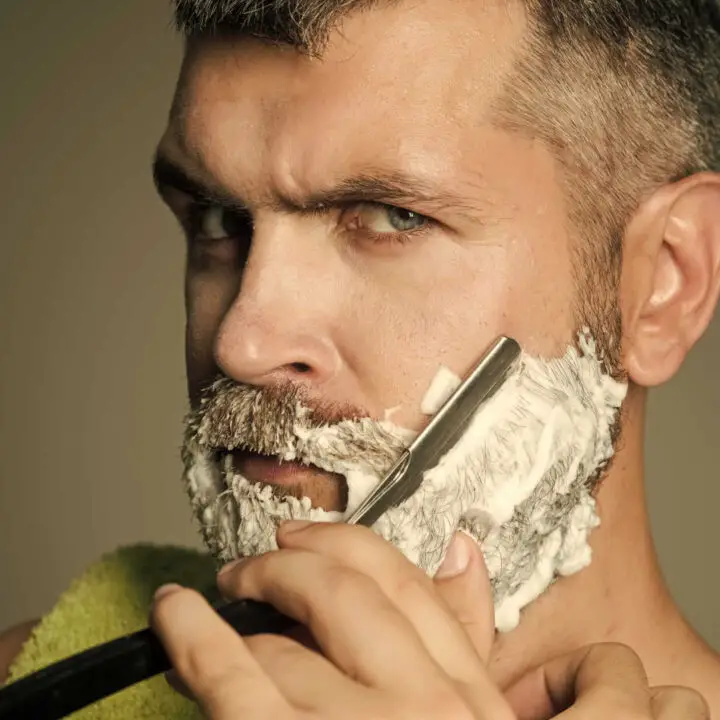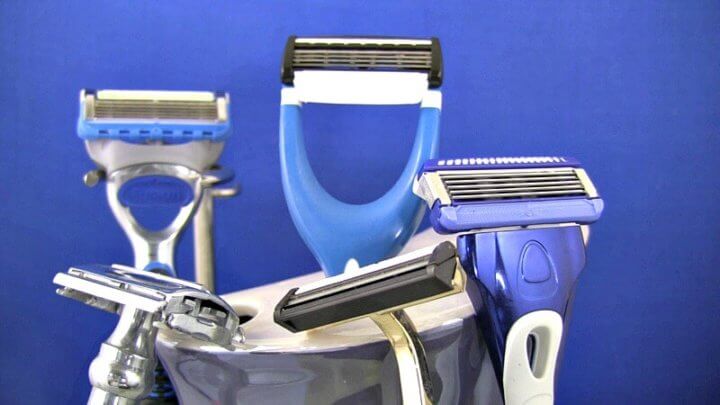
Shaving has a rich history that dates back centuries, offering a glimpse into personal grooming before the invention of modern conveniences. In earlier times, men used straight razors and safety razors, often taking great pride in their shaving ritual. It wasn’t just about hair removal; it was an experience steeped in tradition and skill.
Fast forward to today, where electric razors and disposable options have become the norm. These devices promise speed and convenience, catering to our fast-paced lifestyles. However, this convenience often comes at a cost—a loss of the ritualistic aspect of shaving. With the simple push of a button, the act of grooming transforms from a mindful practice into a mundane task.
The Paradox of Seeking Mindfulness Through Potentially Dangerous Sharp Objects

Ironically, many enthusiasts are drawn to traditional wet shaving precisely because it involves sharp blades. This may seem counterintuitive, yet the potential danger of using a straight razor or a double-edge safety razor compels shavers to focus entirely on the task at hand. The need for concentration fosters mindfulness, as one must be fully present to avoid nicks and cuts.
The Growing Trend of Traditional Shaving as a Rebellion Against Rushed Modern Life
As life becomes increasingly hectic (doom scrolling!), many find solace in the deliberate process of traditional wet shaving. It serves as a form of rebellion against the rushed, multitasking culture that dominates modern existence. Embracing this age-old practice allows lets us slow down, engage with a grooming routine, and carve out a moment of peace in the day.
This shift towards traditional wet shaving reflects a broader desire to reclaim time and attention in a world that often prioritizes speed over quality. The allure of taking 30 minutes for a shave—time that could be spent elsewhere—becomes an act of self-care and a statement against the relentless pace of contemporary life.
The Ritual and Its Components

Engaging in traditional wet shaving is not merely about the act itself; it’s a ritual laden with anticipation and care. The almost religious preparation of tools—brush, soap, razor, and hot towel—transforms an everyday task into a ceremony. Each item plays a crucial role: the brush becomes an instrument of artistry, the soap turns into a canvas for lathering, and the razor symbolizes precision and skill.
Meditative Aspects of Lather Building
Lather building stands out as one of the most meditative aspects of this practice. Is it simply playing with soap? Maybe, but in that interaction lies mindfulness. The swirling brush, the scent of rich soap, and the tactile sensation of creating the perfect lather foster a state of flow, allowing the mind to quieten. This process encourages presence, pulling you deeper into the moment and away from the distractions of daily life.
Mindfulness Through Mandatory Focus

There’s an undeniable tension in traditional wet shaving that demands your full attention. The simple act of wielding a sharp blade close to the skin creates an acute awareness of the moment. One wrong move could result in cuts, nicks, or worse. This inherent risk forces a level of focus that is often absent in our multitasking modern lives. Answering emails or scrolling through social media takes a backseat. In this ritual, it’s just you and the razor.
The Therapeutic Value of Slowing Down
The time investment in traditional shaving may seem extravagant—30 minutes spent on a routine that can take two with an electric razor. Yet, this slowing down is where the true therapeutic value lies. In a society that prizes speed and efficiency, taking the time to care for oneself can feel revolutionary. The morning routine transforms into a meditative practice, a time to reflect and prepare for the day ahead. Rather than feeling rushed, you embrace a moment of calm before diving into daily responsibilities.
The Psychology of Traditional Shaving

Traditional wet shaving presents a possibly unique psychological landscape. It offers the satisfaction of mastering a skill that comes with inherent risks. As users learn to navigate the sharp edge of a razor, they develop a sense of accomplishment. Each successful shave builds confidence, while every near-miss reinforces the importance of focus and patience. This paradox—finding joy in the potential for bloodshed—can create an almost thrilling layer to the experience.
The Placebo Effect of Brass Versus Plastic

When it comes to razors, the material seems to greatly influence perception. Many wet shaving enthusiasts swear by brass or stainless-steel razors, believing they provide a superior experience. This belief often leads to a placebo effect; the knowledge of using an expensive, beautifully crafted tool can enhance the perceived quality of the shave. In contrast, plastic disposables lack this allure, which may detract from the overall grooming ritual. It’s intriguing how the value placed on these tools can elevate emotional and mental engagement with the act of shaving.
Social and Environmental Implications
When considering the environmental footprint of grooming habits, traditional wet shaving stands out as a more sustainable choice compared to disposable razors. Disposable razors are typically made from a mix of plastics and metals, which take hundreds of years to decompose, leading to significant waste in landfills. In contrast, traditional razors, often made of durable materials like stainless steel or brass, can last a lifetime with proper care. This longevity reduces the need for frequent replacements, thereby lessening waste.
Moreover, the production of disposable razors requires considerable resources and energy, contributing to carbon emissions. Traditional wet shaving tools may have a higher upfront cost but result in less overall consumption over time. The shift towards sustainable grooming practices is increasingly appealing, especially to environmentally conscious consumers who want to make mindful choices.
The Peculiar Community of Wet Shaving Enthusiasts

One of the most fascinating aspects of traditional wet shaving is its vibrant community. Enthusiasts gather online and in local groups to discuss everything from the best shaving soaps to the intricacies of lathering techniques. These conversations often delve into the art of creating the perfect lather, showcasing a shared passion that extends beyond mere grooming.
This community thrives on sharing knowledge, tips, and experiences, fostering a sense of camaraderie among those who embrace this ritual. The willingness to invest time and money into quality products reflects a collective value placed on craftsmanship, sustainability, and self-care.
The Economic Paradox of Spending More to Save Money
At first glance, spending more on high-quality razors and grooming products might seem counterintuitive, especially when cheaper disposable alternatives are readily available. However, traditional wet shaving represents an economic paradox. While the initial investment can be significant, the durability of these products means they can save money in the long run.
Many enthusiasts find themselves purchasing fewer items over time, as a well-maintained razor can last for decades. Additionally, the experience of using quality products adds a layer of enjoyment to the grooming routine that many find worthwhile. This shift in mindset—from viewing grooming as a chore to embracing it as an enriching experience—highlights the broader implications of traditional shaving in today’s fast-paced world.
Conclusion: The Modern Relevance of Ancient Practices
In a world that often glorifies speed and efficiency, traditional wet shaving stands as a paradox. While it requires a time investment that can stretch to half an hour or more, the therapeutic benefits it offers are undeniable. This practice transforms a mundane task into a ritual of self-care, promoting mindfulness and encouraging individuals to carve out moments for themselves in their busy lives.
Balancing Time Investment with Therapeutic Benefits
The act of preparing your tools—a brush, soap, razor, and hot towel—becomes a meditative experience. Each component serves not just a functional purpose but also contributes to the overall mindfulness of the process. It begs the question: how much is our mental well-being worth? In an age where we’re bombarded with productivity hacks, taking 30 minutes for grooming might seem excessive. Yet, many find this deliberate slowdown rejuvenating, allowing them to tackle the day ahead with a clearer mind.
The Ironic Appeal of Complicated Simplicity
There’s an irony in choosing complexity over simplicity. In a time when technology promises effortless solutions, opting for a multi-step shaving routine feels like an act of rebellion. This complexity fosters a deeper connection to the act of grooming, turning it from a hurried chore into a cherished ritual. The tactile sensations of lathering and the warm embrace of a hot towel create a sensory experience that is seldom found in quick, modern alternatives.
As we contemplate the relevance of such age-old practices, we recognize that they offer more than just grooming; they provide a vital opportunity for reflection and presence in our fast-paced lives.

Great article, Otto. I’ve also enjoyed some of your other articles and comments on Sharpologist and other wet shaving sites. One morning when I was a 4 or 5 years old, I woke to a strange sound in the hall bathroom; I got out of bed, peeked around the opened door to see my Dad whipping up lather in the shaving mug. He saw me, smiled, and continued his ritual. Several years later at Christmas time when I was 14, Dad gave me a DE razor, shaving brush, shaving mug with soap, and bottle of after shave; this was the beginning of my shaving experience that I’ve enjoyed through the years.